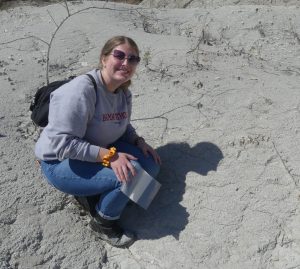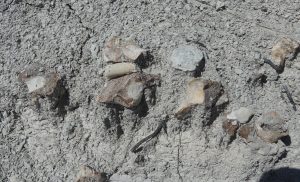On Saturday, March 26, a class field trip was scheduled for students enrolled in the undergraduate Paleontology & Society course offered through the selective Blount Scholars Program at the University of Alabama. The classic fossil locality Harrell Station Paleontological Site in Dallas County was the destination of this trip. Here, Cretaceous-aged (~82 million-year-old) marls of the Mooreville Chalk are exposed in a series of gullies on this 132.5 acre property owned by The University of Alabama. The trip was led by instructor Dr. Adiel Klompmaker, UA Museums’ Curator of Paleontology. A number of avocational (hobby) paleontologists also came along to meet and interact with the students as part of this course.

Less than half hour into the trip on this sunny day, Brianna Day, an aerospace engineering student, asked Dr. Klompmaker to come over. She thought she had found something. She sure did! Several parts of vertebrae of an ancient marine reptile called a mosasaur were lying on top of the marl and several more were still embedded in the rock. Finding loose, single vertebrae of mosasaurs does happen on occasion at Harrell Station, but finding several ones from the same animal is very rare. The bones were carefully excavated and put in a plastic bag for further study. Other students in the class (Sophia Comino, Skyler Dunn, Loren Evans, and Mitchell Lynn) also found numerous fossils that day, ranging from shark and fish teeth, bivalve shells, and worms to single bones.

Most vertebrae came in several pieces. They were prepared out of the surrounding rock and glued back together in the paleontology lab. The puzzle amounted to a total of six vertebrae. Dr. Lynn Harrell, a mosasaur specialist at the Geological Survey of Alabama, and Klompmaker studied the vertebrae by comparing them to mosasaurs in the Alabama Museum of Natural History collection, which houses one of the largest mosasaur collections in the United States. They determined that the vertebrae belong to an individual of the Halisaurinae subfamily. Not only is finding six vertebrae of a single mosasaur animal uncommon, but this taxon is also relatively rare in Alabama. It is fair to say that these vertebrae, with catalog number ALMNH:Paleo:6367, are a great addition to the Alabama Museum of Natural History collection.

Experiences like this help students to understand how to recognize and find fossils, interpret the paleoenvironment, and appreciate the importance of collecting and documenting fossils. The human aspect of paleontology is also an important part of course and this field trip. Students got to interact with avocational paleontologists, several of whom donated fossils of scientific interest that day. One donated lobster specimen made the national news earlier this week.